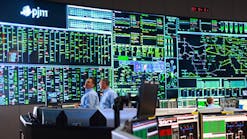Duke Energy is leading the clean energy transition for our customers — modernizing our power grid, generating cleaner energy and accelerating our digital transformation to achieve net-zero carbon emissions by 2050. Yet, achieving this requires a well-trained workforce, equipped with the latest skills to meet the needs of our customers. That’s why we’re embracing the power of cutting-edge technologies like virtual reality (VR) to transform our training, operations and more for the future.
Re-imagining Training with VR
Our VR journey started in Duke Energy’s XR Lab, which was founded in 2018 with a mission to develop an immersive and realistic training experience for employees. The lab is composed of a team of artists and software engineers that used to work for video game studios. Many of these teammates never expected to work for a utility. However, they were inspired by the opportunity to use their creative and technical skills in an essential industry that provides electric and natural gas to millions of customers.
Instead of designing video games, they’re now developing virtual training experiences that simulate reality and allow employees to learn with reduced risk. Wearing a headset, employees are immersed in a virtual environment that looks like a video-game version of their work area. The designers partner with business unit experts to make the trainings as realistic as possible – from the virtual gear users wear to the interactive controls on the equipment.
The XR Lab’s first VR training simulation was developed for natural gas technicians to learn how to vent a natural gas line – a process where employees check and remove natural gas from the line in order to make repairs. They have since designed programs to train wind technicians how to operate substations and another that qualifies natural gas technicians to inspect rights-of-way for leaks, encroachments and other hazards – a test that is difficult to conduct in a real right-of-way. In the latter application, once a trainee detects a hazard, they describe to an evaluator what they’re seeing to show they understand the material. If they make a mistake, they get real-time feedback to learn the correct action.
Improving Employee Safety and Operations
These VR solutions create a safe space for our frontline workers to practice processes and procedures as many times as needed and without any inherent risk – which, in turn, improves their ability to retain information and perform in the real world.
Duke Energy technicians who trained through VR are able to perform tasks three times faster than technicians who received classroom-based training. Of the Duke Energy employees who have used VR training, 94% said it would help them do their jobs better. In addition, a 2020 PricewaterhouseCoopers study showed VR learners are four times more focused than e-learning students and 275% more confident in applying skills after training.
Using VR, our natural gas business projects to save approximately three hours in training time per technician per course. They forecast this will lead to annual savings of more than $500,000 in operational costs, including travel and instructor expenses.
The benefits of VR are practical, too. Using a virtual three-dimensional replica of one of our nuclear power plants, workers can view the systems and components in the nuclear reactor building at any time. Previously this could only be done during a nuclear refueling outage, which occurs roughly once a year. With access to this information year-round, we can better plan for future facility maintenance and modifications, improving reliability and efficiency for customers.
Transforming for the Future
At a time when climate change and the future of the energy industry are front and center, VR training is giving employees more flexibility and equipping them with the skills and qualifications needed to fulfill emerging positions, like operating and maintaining cleaner forms of generation.
Duke Energy is also using VR to power the next generation of utility workers, giving students an inside look at how we generate and deliver power. With our modern workforce development application, students can put on a headset and navigate a series of interactive virtual challenges, serving as an engineer, lineworker and relay technician, right from their career fair. The application won a Nuclear Energy Institute Top Innovative Practice award in 2020.
Keeping Pace with Constant Change
While the pandemic drastically disrupted traditional learning and collaboration, it tested and proved the strength of our digital transformation, which began in earnest in 2018. Our early investment in digital positioned us to respond to challenges with agility and continue executing our strategy as the industry transforms.
Now, we’re leveraging this technology to create a new revenue stream. With Virtual Crew, Duke Energy can customize simulated field training and qualifications for energy companies and contractors nationwide, as well as offer existing VR trainings.
With change as the only constant and the already rapid pace of change increasing, all industries are becoming technology companies. In the energy industry, Duke Energy is redefining what it means to be a utility – infusing virtual reality into training, operations and more to advance the pace of its clean energy transition and deliver greater value to its customers and employees for decades to come.
Richard Donaldson is vice president, Digital Transformation, at Duke Energy.


